Church
About Andrew Cusack
 Writer, web designer, etc.; born in New York; educated in Argentina, Scotland, and South Africa; now based in London.
Writer, web designer, etc.; born in New York; educated in Argentina, Scotland, and South Africa; now based in London. read more
News
Blogs
Reviews & Periodicals
Arts & Design
World
France
Mitteleuropa
Knickerbockers
Argentina
The Levant
Africa
Cape of Good Hope
Netherlands
Scandinavia
Québec
India
Muscovy
Germany
Academica
San Fernando Cathedral
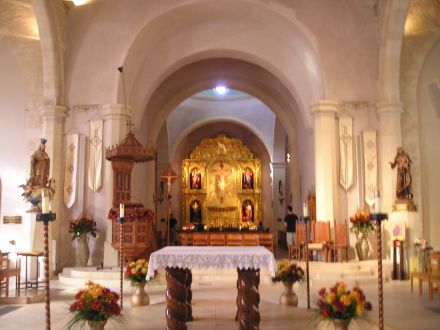
SAN FERNANDO CATHEDRAL in San Antonio, Texas, named after the holy King Ferdinand III of Castile, is one of the oldest cathedrals in the United States. Indeed, there is considerably debate as to precisely which church is the oldest cathedral in the United States. The Baltimore Basilica, recently restored, was the first cathedral to be located in the political entity known as the United States. The Cathedral Basilica of Saint Augustine in the Floridian city of that name was founded in 1594 (making it the oldest parish in the U.S.) but the current structure was not built until 1793, and the church did not become a cathedral until 1870. The core of San Fernando was built from 1738 to 1750, but the nave was replaced in 1868 with one of a neo-Gothic design. It became a cathedral when the See of San Antonio was erected in 1874. So the Baltimore Basilica (or the Basilica of the National Shrine of the Assumption of the Blessed Virgin Mary, to give it its full name) was certainly the first cathedral in the United States, though not the oldest church serving as a cathedral. To add to the fray, the Cathedral of Our Lady of Peace claims that it is the oldest continuously operating cathedral in the United States, since the Baltimore Basilica is no longer the cathedral of Baltimore, but rather merely co-cathedral to the bizarre art-deco-gothic Cathedral of Mary Our Queen in that city. It’s all quite mad really. Suffice to say, San Fernando is old and it is a cathedral; it’s an old cathedral. (more…)
The Rosary Crusade
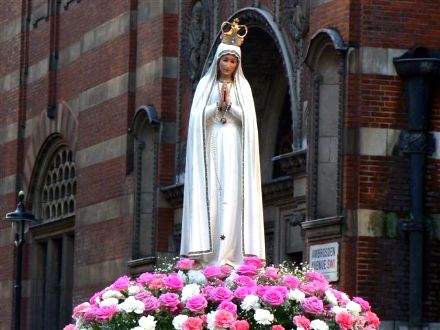
THE BLESSED VIRGIN HAS quite the legion of followers at her beck and call, and a good many battalions (perhaps even a regiment?) turned up on October 14 for the annual Rosary Crusade for the reparation of sins. The event began with a procession from Westminster Cathedral near Victoria Station, through the streets of London, to Brompton Oratory in Kensington. A statue of Our Lady was borne aloft by members of the Catholic Police Guild the whole way to the Oratory, where Benediction was held. We bring you these photos, taken by, amongst others, Matt Doyle, and Ken Simpson, all of which we found via ‘Joee Blogs‘, a Catholic medical student in London.
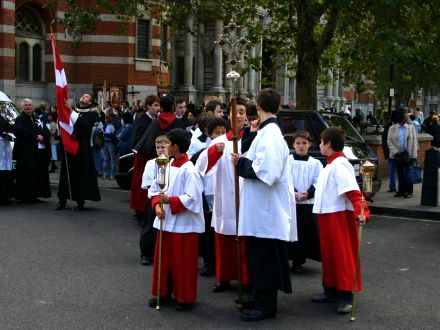
Our Holy Emperor
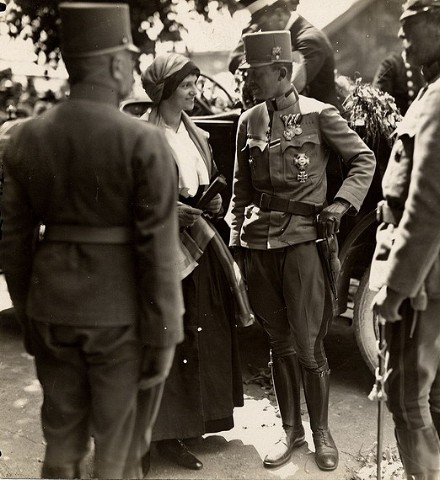
OCTOBER 21 IS the feast of Blessed Charles of Austria, the saintly emperor of that sacred realm whose life stands as an example of the price of sanctity. Charles worked tirelessly for peace both between the peoples of his own numerous realms and between all the nations, seeking to bring to an end the ceaseless and suicidal slaughter of the Great War, in the midst of which he had ascended to the throne of his fathers. A defender of social order, Charles reminds us of our many responsibilities to each other, even though the spirit of our current age would have us clamor only for our supposed rights. In the face of repeated betrayal and intense pressure, he refused to abdicate and so abandon his peoples to their fates, which were terrible indeed. That terrible cross he bore, the crown, was in fact a penitential grace, the sufferings he bore for the benefit of his – and indeed all – people. His reward was not in this world.
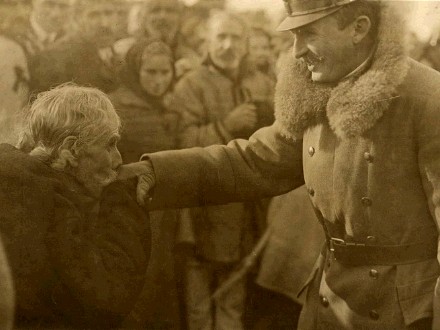
James II, Our Catholic King
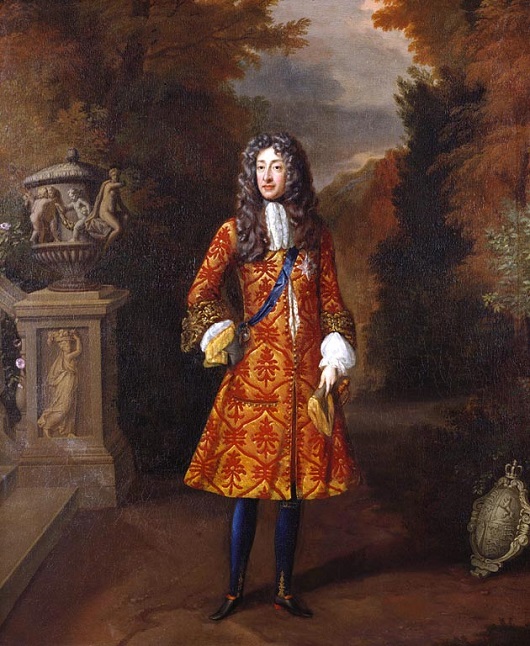
THIS PAST SATURDAY was the anniversary of the birth of King James II and VII of England and Scotland. The third son of Charles I, he was baptised into the Anglican church six weeks after his birth and was created Duke of York at eleven years of age. James married Anne Hyde, the daughter of the Earl of Clarendon, by whom he fathered eight children, though only two survived past childhood.
In 1664 the Duke of York equipped an expedition to relieve the Dutch of responsibility for their colonies in North America, and henceforth New Amsterdam and New Netherland were known as New York after their new Lord Proprietor.
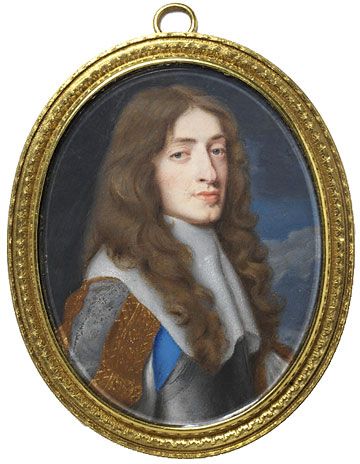
Sometime during the year 1670 both the Duke and Duchess of York were received into the Catholic Church and stopped attending Anglican services, though the conversion did not become public knowledge until the Test Act (requiring officeholders to receive communion in a Church of England service and take an oath against Transubstantiation) was passed three years later. James was forced to renounce his offices, such as Lord High Admiral of England, though not his titles. At any rate, Anne, the Duchess of York had died in 1671 only a year after her conversion. He married Princess Maria of Modena in 1673.
The Protestant oligarchs felt threatened by the prospect of a Catholic king and thrice tried to pass laws barring James from succeeding to the throne. However his elder brother Charles II, the reigning king, dissolved parliament each time before the bill was to be passed. King Charles II died in February 1685, (having reconciled himself to the Catholic faith before his end) and thus the Duke of York was proclaimed James II of England and VII of Scotland. A private Catholic coronation was held at Whitehall Palace on April 22 before the public coronation the following day on the feast of Saint George, which was performed according to the rites of the Church of England.
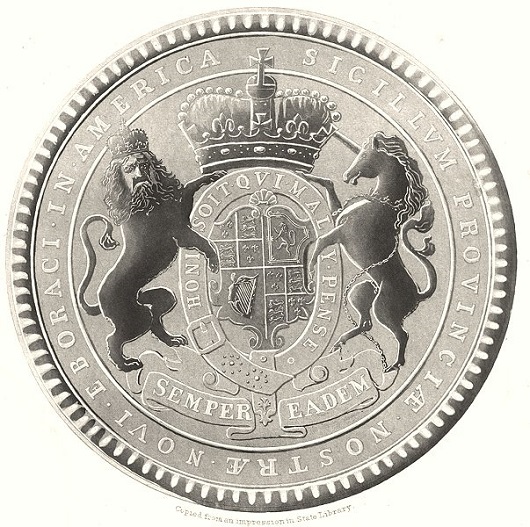
James had appointed the Catholic Thomas Dongan
as Governor of New York in 1682.
The Protestant oligarchs’ fears that James would end their hegemonic grip on Scotland and England proved well-founded as in 1687 he issued a Declaration of Toleration as King of Scotland, allowing Catholics, Episcopalians, and other non-Presbyterians to hold public office and the right of public worship, and a Declaration of Indulgence as King of England removing the laws penalizing non-attendance or non-communion at Church of England services, permitting non-Anglican worship in private homes or chapels, and abolishing religious oaths for public offices. Furthermore, James had allowed Catholics to hold positions at the University of Oxford for the first time since the Protestant Revolution. More provocatively, he tried to transform Magdalen College Oxford into a Catholic seminary. He had already reckoned with the rebellion of the Duke of Monmouth who proclaimed himself king two years earlier but had been captured, tried, and executed for treason. With the birth of a Catholic son and heir, Prince James Francis Edward, in 1688 a cabal of seven Protestant nobles issued an invitation to William of Orange, the Protestant Stadtholder of the Netherlands. A few months later, William of Orange duly arrived and usurped the throne, having already married James’ daughter Mary from his first marriage. The two ruled jointly as William and Mary.
Unwilling to create a popular martyr as had happened with the executed Charles I, William allowed James to escape and fled to France where Louis XIV gave the exiled monarch the use of a palace and an ample pension. James was intent on returning to his birthright, however, and took advantage of the Irish parliament’s refusal to recognise William’s usurpation of the throne. The King landed in Ireland in March of 1689 at the head of a Franco-Irish army but was defeated by William in the famous Battle of the Boyne in July 1690, and returned to his place of exile in France.
There, Louis allowed him to live in the château of Saint-Germain-en-Laye and offered to get James elected King of Poland but James felt this would prevent any chance of a Stuart again holding the throne of England. From that time onwards, James led a simple life of penance in reparation for his sins (he had had a number of mistresses in his younger days) and finally died in 1701. He was entombed in the Chapel of St. Edmund within the English Benedictine church on the Rue St. Jacques in Paris, while his brain was sent to the Scots College in Rome, his heart to the Visitandine Convent at Chaillot, and his bowels divided between the College of St. Omer (the exiled English Catholic school, now Stonyhurst in Lancashire), and the nearby parish church of St. Germain where they remained until they were desecrated by a Revolutionary mob and lost forever. His monument at Saint-Germain, however, was rediscovered in 1824 and is proudly displayed there to this day. There is also a monument to James and the Stuarts in St. Peter’s Basilica in Rome (c.f. Roma – Caput Mundi).
Aside from the pious tradition that Edward VII was received into the Church on his deathbed, James II was the last Catholic king (and as good King Edward never reigned over New York, James is even more certifiably so for us). There is a lovely coronation ode to James which I just might bring to your attention someday. But for now, reflect and remember our monarchs of old and pray that God in His mercy might grant us good Catholic rulers in stead of the shabby lot we elect today.
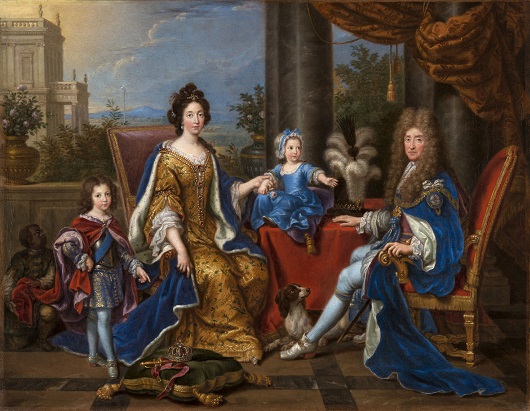
The Auld Scotsman

ONE THING WE greatly enjoyed about the Scotsman in its pre-tabloid days was that they often deemed St Andrews social events worthy of coverage in their august pages. It was a source of pride to see ‘the national newspaper’, a respectable broadsheet, covering events at the oldest university in the land (which we are proud to call our own). Naturally, once the conversion to tabloid size was complete, we were rarely heard of again, which was a little saddening. The Scotsman is not what it used to be —a beautiful, well-designed, informative respectable newspaper— but it still manages to print some thoroughly worthwhile articles which is more than can be said of any other Scottish daily. (One need only point out two articles by Prof. Haldane, c.f. here and here, recently posted on this site).
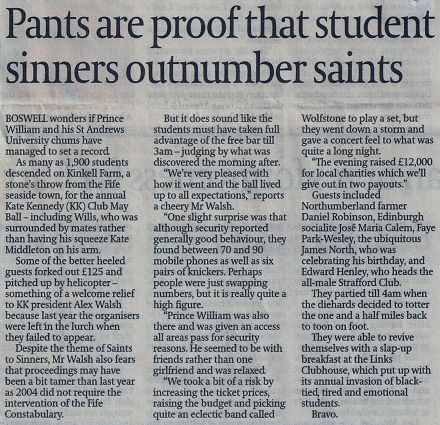
“…when the diehards decided to totter the one and a half miles back to toon on foot.” Sounds familiar.
Admittedly, most of the events covered were organised by the Kate Kennedy Club, which seems to take pride in the sheer vulgarity and tastelessness with which they advertise many of their events. (This is only slightly mitigated by their superb running of the annual Kate Kennedy Procession). Still, we enjoyed the Scotsman‘s coverage and wish it had continued. I only bought the Scotsman on occasion after the switch, but often gave the Common Room’s copy a browse when I lived in St. Salvator’s. (Its Sunday edition, Scotland on Sunday is worth buying for Gerald Warner alone).
Here are a few bits and pieces clipped from the Scotsman for your perusal:
‘Undampened spirits take the party indoors‘ / Lumsden Club garden party moved indoors on account of the rain. (I didn’t go).
‘High jinks and low cuts at Kate Kennedy’s‘ / This covered the Kate Kennedy Procession dinner which takes place at the Old Course Hotel on the evening following the procession. This particular year I was in attendance myself and recall commiserating with Michelle Romero, that charming daughter of Venezuela, about the troubled state of her native land. I was their with our favorite Dane, Sofie von Hauch, and my flatmate, a member of the KK who wishes to remain unnamed on this site. Will Lyons couldn’t make the dinner himself, so he sent ‘K‘ up instead, accompanied by ‘society photographer Z‘ whom I ran into while we were on our way out.
‘Maltesers set ball rolling for charity‘ / The 2004 Knights of Malta Ball, not covered by this website because it did not exist at the time. It was a good time, especially so because I had three friends over from the States. Yalie Adam Brenner was doing his semester abroad at St Andrews at the time, and fellow Old Thorntonian Clara de Soto popped over from Boston College for the weekend with her good friend Katie Cordtz of Atlanta. The four of us together with Michelle Romero and the aforementioned unnamed flatmate of mine piled into a cab and made the hour’s journey to Edinburgh for the soirée. Poor Adam, though. Towards the latter part of the evening Archie Crichton-Stuart, an exceptionally amusing Edinburgh student, and his friend Ramsay forced Adam to consume the significant remnants of a bottle of house red. It all went down swimmingly, but came back up on the cab ride back to Fife. Freddy McNair, who was recently nearly killed by an incompetent gurkha on a training ground, sat at the table next to ours, I recall. (Also, in the lower right-hand corner of the clipping you can spy the face of our good friend Ricky Demarco peering out from an unrelated article).
Previously: Another Broadsheet Bites the Dust
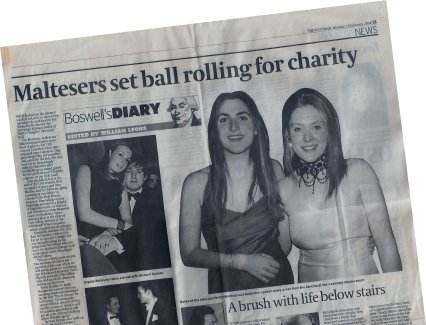
Without family & faith we’ve lost our way
by JOHN HALDANE
THE SCOTSMAN | Friday 1 September 2006
DR JOHNSON’S memorable observation that “nothing so concentrates the mind as the prospect of imminent hanging”, has provided a formula for highlighting other attention-focussing threats. Currently, for example, the minds of Scotland’s MSP’s may be said to be concentrated by nothing so much as by the prospect of next year’s Holyrood elections.
It is reported that Labour and the SNP are each holding strategy discussions to prepare for May’s poll. The latter in hope of victory, the former in fear of defeat. Meanwhile, the Liberal Democrats try to look principled while yet pondering the best bet for coalition partners; Conservative MSPs are under attack from within their own party for their mediocre performance; and Scottish Socialists are breaking apart and regrouping in smaller cells. Concentrating the mind is rarely easy, often uncomfortable, and sometimes destructive.
So much for the politicians, what of the electorate? or more aptly, in times of declining voter participation, what of the people of Scotland? It is clear that here, as in the UK more generally, people have little confidence not only in politicians but in politics. Apart from cynicism encouraged by decades of scandals which, whatever their differences, give the general impression of exploitation of office; there is the feeling that most policies simply fail to make life better.
Vienna on 43rd Street
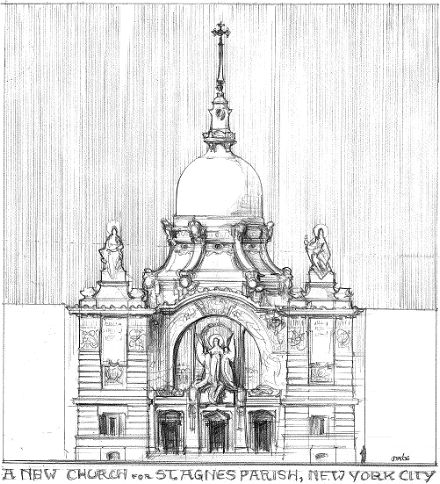
A WEEK AGO AFTER the 11 o’clock Sunday Mass at St. Agnes, Dino Marcantonio, Matt Alderman, and I stood in front of the church and fantasized about how we would fix the old place. Well, perhaps ‘old’ isn’t the right word for the place. While the parish was founded in the 1840’s, the current church building only dates from the late 1990’s, built after the old Victorian edifice was consumed by fire. As for design, its heart is in the right place, but as they say the Devil is in the details. The interior is marred by quite obviously large joints between component parts of arches and cornices and the exterior just looks fake. Is craftsmanship dead? No, but it helps to search it out instead of accepting just any old thing.
At any rate, Matt Alderman has thrown together these esquisses of what his St Agnes would look like, and it’s all rather Austrian. (more…)
Gabriel García Moreno
Ecuador’s Saintly President
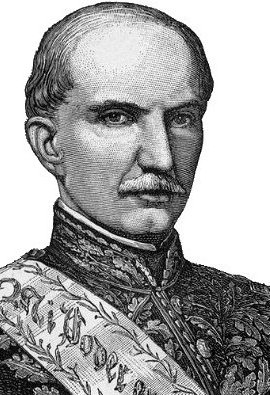
WE LIVE IN an age which is almost completely devoid of Christian statesmen. In their stead, we are today ruled by faceless bureaucrats and vapid masters of spin. Gentlemen once sought public office in the hopes of ensuring order and the public good while dark and knavish men sought the same in their lust for power. The politicians of today, meanwhile, tend to be of neither inspiration but rather seem all too often to have engaged upon the ‘career’ of ‘public servant’ because they lack any of the skills necessary to succeed in any real, productive employ, station, or vocation. Given the sad state of affairs in our day, we must look to the past — to another age and indeed another continent — in our search for models of Christian leadership in the temporal realm of a modern republic. In this search, the name of the journalist, scholar, statesman, and saint, President GABRIEL GARCÍA MORENO of Ecuador, stands taller than any other in the Americas. (more…)
The Assumption

Nicolas Poussin, The Assumption of the Virgin
Oil on canvas, 22″ x 16″
1650, Musée du Louvre, Paris
Click here for a closer view.
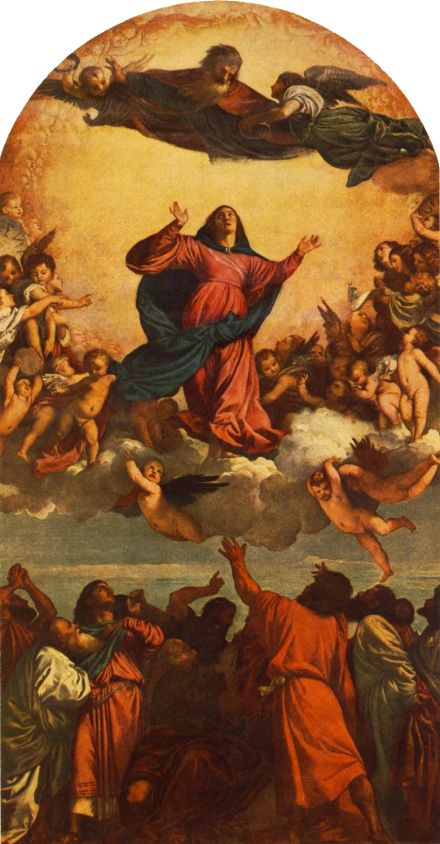
Titian, Assumption of the Virgin
Oil on wood, 272″ x 142″
1516-18, Santa Maria Gloriosa dei Frari, Venice
Monarchs and Presidents in Islam
National Review, Nov 21, 1986
by Erik von Kuehnelt-Leddihn
IN THE Islamic world’s relations with Israel, the hard-liners are the various Arab and non-Arab republics. When there is any sign of softness, it comes, almost always, from one of the monarchies. (Egypt, and Egypt alone, is the exception.) It thus did not come as a great surprise that King Hassan II of Morocco agreed to meet with the then Israeli prime minister, Shimon Peres, this summer.
While individual monarchs historically may have been capricious or cruel, monarch as an institution is inclined to be generous: Montesquieu has told us that while the driving element in republics is virtue, in monarchies it is clemency. And, indeed, the Islamic monarchs of old were infinitely more tolerant than their modern republican successors. They traveled extensively, and many had a cosmopolitan outlook. Some had relatives abroad. When King Hassan II of morocco writes to members of Europe’s royal families, he addresses them as “cher cousin” or “chere cousine,” since he is a descendant of Mohammed’s daughter Fatima, as by now are all the Christian royal families. (Many centuries ago, a Moroccan prince was taken prisoner by the Castilians and converted in captivity. After his release he married into a princely family, and over the centuries his bloodline has spread into countless aristocratic and royal families.) In chooing their administrators, officers, diplomats, bankers, and doctors, Islam’s monarchs looked for able men regardless of religion, never caring whether their choices were popular or not.
It is true that local slaughters of Christians took place in various parts of the Turkish Empire, but things got really bad only when the enlightened, highly nationalistic Young Turks appeared on the scene. Their political organization was called “Unity and Progress,” by which they meant ethnic uniformity and modern methods. It was they who were behind the big Armenian massacres during World War I. The Turkish sultans, by contrast, frequently gave preferment to Christians (and sometimes Jews) in high positions. The Phanariotic Greeks, so called after the Lighthouse Quarter of Constantinople in which most of them lived, acted as trusted administrators; the governors of the Rumanian-speaking provinces, for instance, were taken from their families.
Very typical is the story of a family known to me. Originally called Black, they were Scots and good Catholics who emigrated after the fall of the Stuarts and settled in France, where they Gallicized their name. There are still Blacques in France, but one branch of the family emigrated to Turkey, where its scions made a splendid career without changing either their name or their religion. One of them, Edward Blacque-Bey, became the last Turkish imperial ambassador in Washington. (His sons, too, made diplomatic careers. One married an American, and his son, having graduated from Harvard, became a colonel in the U.S. Marines and later an American diplomat.) Edward Blacque-Bey wore a fez and was a loyal subject of the sultan, under whom Constantinople became an international metropolis. All this ended with the republic under Ataturk.
Similar conditions existed in the kingdom of Egypt before Nagib and Nasser. Forty per cent of the administrators and civil servants were Coptic Christians, who considered themselves the genuine descendants of the Old Egyptians. Before 1952 Cairo was an eastern Paris, where Christians and Jews played an important role–socially, commercially, politically, Arab nationalism put an end to all this, not only in Cairo, but also in Alexandria, which is so well described in Lawrence Durrell’s Alexandria Quartet. In Iran–a non-Arab state–the old monarcy under the Kajar dynasty and the more recent one under the Pahlavis were notably tolerant. Non-Muslims (such as the still-surviving Zoroastrians) could make all sorts of careers, and the country’s political orientation was Western. The window to the West remains open in the Islamic monarchies of today–in Morocco, in Saudi Arabia, in Oman, and even in Malaysia.
MONARCHIES HAVE the advantage that, although they might be oppressive toward the political ambitions of their subjects, they are never totalitarian. To my knowledge there is no Jewish community left in Algeria, but there still is a small one in Morocco. Variety is the keynote of monarchies, and with it goes internationalism. In 1910 only two sovereign nations in Christian Europe had truly native dynasties: Serbia and Montenegor. (Peter III was the last genuine Romanov; the Hohenzollerns were not Prussians but Swabians; and so forth.) These dynasties could often follow unpopular policies, both domestic and foreign. Popular policies are not always good for the country, and the courage required to stick to an unpopular good policy is immensely rare among politicians in democracies. They crave popularity and want, above all, to be re-elected. King Hassan II might be trembling lest he be assassinated by fanatics, but he pursues policies that he considers to be right. He certainly is not guided by Sir Henry Campbell-Bannerman’s idiotic dictum, “Self-government is better than good government,” which is roughly equivalent to saying that self-treatment in case of illness is better than treatment by a qualified physician.
America’s Latest Basilica
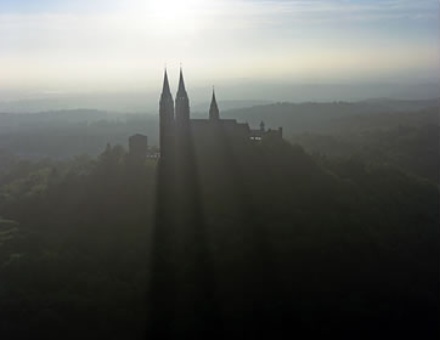
Holy Hill, the National Shrine of Mary, Help of Christians, has been named a basilica minor by the Holy Father. The Carmelite friars came from Bavaria to found the monastery at this hill in Wisconsin one hundred years ago in 1906. While the invocation of Mary as Help of Christians (Auxilium Christianorum) began in the 1500’s, the feast of Our Lady, Help of Christians was instituted in 1815 by Pope Pius VII in thanksgiving to God and Our Lady for the freedom of the Papacy and of Europe brought about by the defeat and exile of Napoleon Bonaparte.
Via the Holy Whapping.
Above photograph of Holy Hill by Carl Waltz
Dawn Eden in the Irish Times

This morning I was browsing the front pages of a few of the world’s leading dailies and came across the Irish Times. I thought to myself “My, that lady bears a striking resemblence to Dawn Eden.” Then I read the headline ‘Chastity Can Make You Happier, Says Author’ and thought to myself “How bizarre! That sounds just like something Dawn would say.” Finally I put two and two together and thought “Crikey! That is Dawn!” C.f. the Dawn Patrol.
Our readers will no doubt recall that Dawn mentioned my comments regarding the Brooklyn Museum’s mauling of their own façade in her Daily News column. More recently she’s written a book and has been buying refrigerators for nuns.
Elsewhere: Superpower: The View from New York – Matt Alderman reports on a night on the town with Dawn Eden including the ever-prescient and incisive wisdom of Andrew Cusack
The Rome of the West
The Churches of Glorious St. Louis, Capital of Middle America
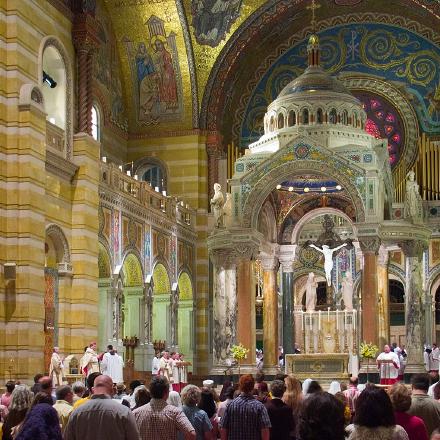
WE ON THE EASTERN Seabord often think that our cities are the last word in ecclesiastical architecture, but Mark Scott Abeln’s splendid ‘Rome of the West‘ site goes a long way towards reminding us of the great physical deposit of Western Civilization and Christian culture situated in the city of St. Louis on the Mississippi River, deep in the heart of America. To show my fellow provincial knickerbockers the richness of St. Louis’s church architecture, I’ve chosen a few photos from Mr. Abeln’s site for posting on this site. A wonderful exhibiton of America’s (which is to say Europe’s) rich cultural heritage.
The jewel in this crown of Catholic Middle America is most certainly the Cathedral Basilica of Saint Louis (above and below). The Cathedral was begun in 1907 and contains the largest collection of mosaic artwork in the world covering 83,000 square feet, the last tesserae of which was installed in 1988. The architecture of the basilica features a number of styles, from the Romanesque Revival exterior to the Byzantine plan and interior, and even contains a chapel designed in the Viennese Reconstructionist style. (more…)
Major General Lord Monckton of Brenchley, 1915-2006
Knight Grand Cross of Obedience of the Order of Malta
Maj-Gen the 2nd Viscount Monckton of Brenchley, who has died aged 90, was awarded an MC in 1940 and later became director of Army public relations at a time when the Armed Forces’ public profile was growing in importance.
At 50 he retired early to run his 350-acre farm in Kent and to join the boards of a series of firms to help pay for the education of his five children. In the House of Lords he became a persistent critic of the neglect of rural and military interests, and took a lifelong interest in archaeology and water divining.
The sole Roman Catholic trustee of a £3 million appeal for Canterbury Cathedral in 1974, Monckton was president of the British Association of the Sovereign Order of Malta, and helped to ease strained relations with its Anglican counterpart, the Venerable Order of St John of Jerusalem, by taking part in ecumenical services.
He also played a key role in forming the Order of Malta Volunteers, who aid the sick at the shrine of Lourdes, and in setting up trust care homes with the Venerable Order.
Roma – Caput Mundi
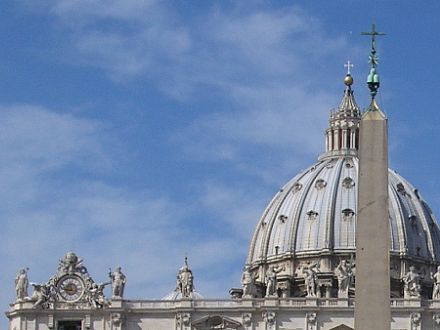
Well I’ve finally got around to putting up my report of our pilgrimage to Rome in March, with a plethora of accompanying photographs. It was an amazing time; Easter excepted, it was the jewel in the crown of our penetential season. Read about it all here.
Clerics of the Old School
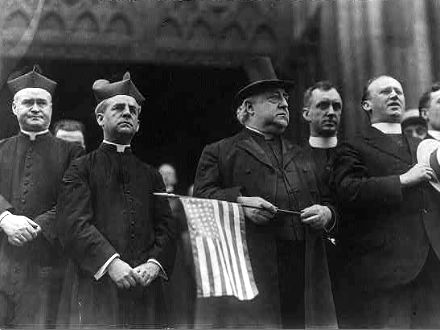
Msgr. Lavelle and others review the 69th N.Y. Regiment from the steps of St. Patrick’s Cathedral, 21 June 1916.
Previously: Your Royal Highness, Caed Mile Failte | Fighting 69th: Home for St. Patrick’s Day
Resurrection
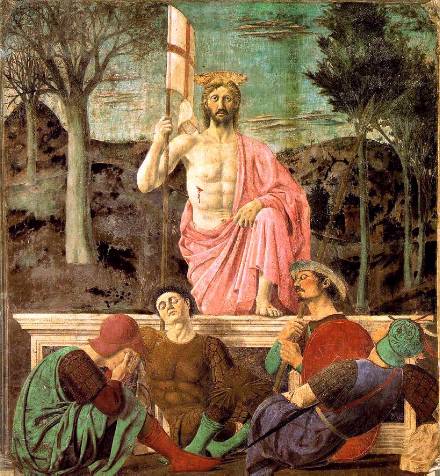
Piero della Francesca, Resurrection
Mural in fresco and tempera, 88″ x 86″
1463-1465, Sansepolcro
A Happy Easter To You All!
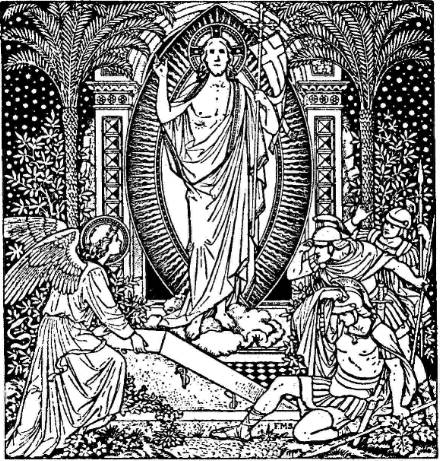
A very pleasant Easter here in St Andrews. The vigil last night was rather nice, and practically by accident. We all got roped into doing some of the readings, much to our own collective chagrins since we’re not real participatory type when it comes to liturgy. But it ended up being appropriate since this is, for a number of us, our last Easter in St Andrews. Alex Harrod did the first reading, Matt Gorrie the second, Amanda ‘Commanda’ Brennan the third, yours truly the fourth, Abby the fifth, Jon Burke the sixth, and Clare the seventh reading. Naturally we all went to the Russell afterwards for a pint, and it was generally decided that Burke read the best.
Then this morning to Step Rock Cottage for a classic fry-up. Toast, sausages, pancakes, and potato waffles, liberally buttered and doused in maple syrup. An absolute delight and perfect for Easter morning. We made gluttons of ourselves while browsing the Sunday papers, then watched the Urbi et Orbi message and blessing (for which, Cardinal Castrillon Hoyos informed us, we received an indulgence!), followed by Charlton Heston and Rex Harrison in The Agony and the Ecstasy. Tonight, dinner at Canmore, hopefully followed by the penultimate installment of The Scarlet Pimpernel in our weekly counter-revolutionary film series at the Chaplaincy. Vive le Roi!
Speaking of which, in addition to being the feast of the Resurrection, this day is also blessed with the anniversaries of the birth of two of Europe’s remaining sovereigns: Pope Benedict XVI himself and dear Margrethe II, the Queen of Denmark. We hope and pray they both have many more returns on the day, in happiness, peace, and prosperity.
Interesting Juxtaposition

Above, the Los Angeles ‘Religious Education’ Congress. Below, the Berlin Olympics. No comment!
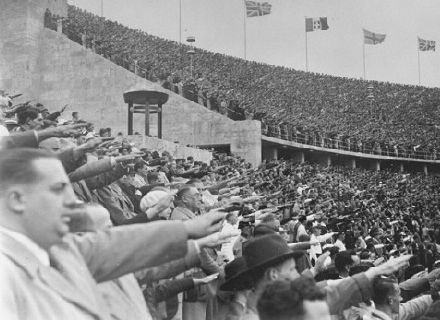
Thoughts of Late
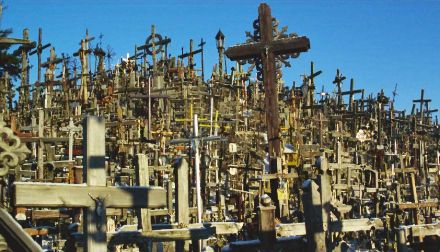
The Hill of Crosses in Lithuania. Over the years, the faithful left crosses on this hill to praise God and signify their appreciation for the many graces and mercies bestowed by Him. During the Soviet occupation of Lithuania, the hill was twice demolished and cleared by the Communists. Each time it was reconstructed by the people, and on its third appearance the Soviets finally allowed it to stay. Despite strong evidence of Christian faith such as this, the University of St Andrews ‘Christian Union’ claims that Lithuania is a heathen country, ‘with only 35 Christians’.
 During my presence at St Andrews over four years, it has snowed on a few occasions, though never stuck for more than a few minutes. I was much pleased, then, to awake on March 2 and spy through my windows (I never draw the curtains, as I enjoy the early morning sun) a blissful wintry utopia. The auld gray toon had been transformed into a veritable snow-globe, with snowflakes shifting back and forth with the wind as gravity drew them nearer their earthly home. Delightfully, this snow lasted, affording thousands of students myriad opportunities for heavenly mischief and giving me an excuse to put on my trusty Sportos. (Trusty Sportos seen at right).
During my presence at St Andrews over four years, it has snowed on a few occasions, though never stuck for more than a few minutes. I was much pleased, then, to awake on March 2 and spy through my windows (I never draw the curtains, as I enjoy the early morning sun) a blissful wintry utopia. The auld gray toon had been transformed into a veritable snow-globe, with snowflakes shifting back and forth with the wind as gravity drew them nearer their earthly home. Delightfully, this snow lasted, affording thousands of students myriad opportunities for heavenly mischief and giving me an excuse to put on my trusty Sportos. (Trusty Sportos seen at right).
But, woe of woes, I had a presentation to give that afternoon on the mundane and irascibly dull subject of the historiography of Indian/Settler relations in colonial America. I, and about four or five others out of a class of nearly twenty, duly arrived in the Old Library of St. John’s House at the appointed hour. We, the few, pondered where everyone else was. Had they autonomously declared a holiday? Risky business, considering this was a tutorial, and thus required, unlike lectures, of which I likely attended less than a third of my due during the past four years. A kindly secretary came in to inform us that Dr. Hart had cancelled the class and thus we were all free to frolic in the abundant snow to our little hearts’ content. Naturally, I just went to Rosary.
Speaking of Rosary, one day the week previous the post-Rosary revelry nearly drank the town dry. Well, perhaps I ought to give some background to our bliss. The Rosary is said every day Monday through Friday in St. James Church at 1:30 after which we all process across the street to the Common Room in Canmore. One or two of the girls, or Adrian if the girls are absent, make a round of tea for the merry band of Marian devotees. Well, on this frigid day in Scotland (a land of poorly-heated buildings, if one’s lucky enough to have heating on at all), we all huddled by the electric fire in our chairs, surmounted by a large communal blanket. Tom brought a bottle of port, of which we all partook, before I then excused myself to go off and do some equally time-wasting task. Well apparently the Rosary crew finished off that bottle of port, and then went and purchased another one! What’s more, the rapacious dipsomaniacs, once they had finished that bottle of port they emptied the reserve bottle of whiskey I keep hidden behind the German dictionaries in the library upstairs. Disgraceful! I have decided not to replenish the secret reserve, since, to put it in the vernacular parlance, is nae secret anaemoor!
Of course it’s my own fault for leaving it in the Chaplaincy. Should I have hidden it in the chaplaincy of the very friendly heretics over in St. Mary’s Place across from the Students Union, it would have remained unmolested. The worse that could happen would be the Christian Union forming a prayer circle around it and praying for the Good Lord to make it go away. (We Catholics already posess the knowledge on making drink disappear, and how!).
Ah, the ‘Christian Union’! Not in the entire English-speaking world, I daresay, does there exist a more delusional body of people. Everything about them is either hilariously funny or pitably sad, beginning with the irony of their very name. The Christian Union, as it styles itself, actually bans most Christians from joining. Those who wish to sign up (poor fools!) must be willing to sign a statement of faith extolling the tenets of the Evangelical Protestant religion. Thus Catholics, Orthodox, and even most Anglicans are not allowed to join. I have sometimes posited contacting whichever bureau of Britain’s behemoth government is responsible for truth in advertising and trying to get them to get the Christian Union to change their name. ‘Evangelical Society’ would be the most appropriate; while ‘Society of Over-Emotional Self-Deluding Followers of Feel-Good Teddy-Bear Christianity’ might be more accurate we must give some allowance for PR these days.
One of the latest projects of the Christian Union is to work for the ‘Christianization’ of Lithuania, “since there are only 35 Christians in the entire country”. It has apparently escaped the C.U. that Lithuania was Christianised ten centuries ago and has remained a vibrantly Christian country, even through decades of Soviet persecution. But perhaps we should leave them in their self-delusion, if only for the hilarity it provides for the rest of us. One can almost imagine them being given demographic information about the population of heaven, with thousands upon thousands of the patriarchs and prophets of the Old Testament, the apostles, the Church fathers, the martyrs, confessors, priests, nuns, and all the legions of holy souls: “But there are only 35 Christians!”
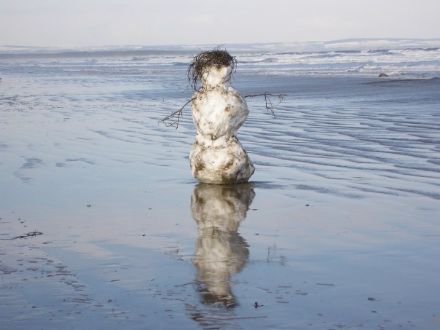
Search
Instagram: @andcusack
Click here for my Instagram photos.Most Recent Posts
- A Christmas Gift from the Governor December 24, 2024
- Oude Kerk, Amsterdam December 24, 2024
- Gellner’s Prague December 19, 2024
- Monsieur Bayrou December 18, 2024
- Dempsey Heiner, Art Critic December 17, 2024
Most Recent Comments
Book Wishlist
Monthly Archives
Categories


